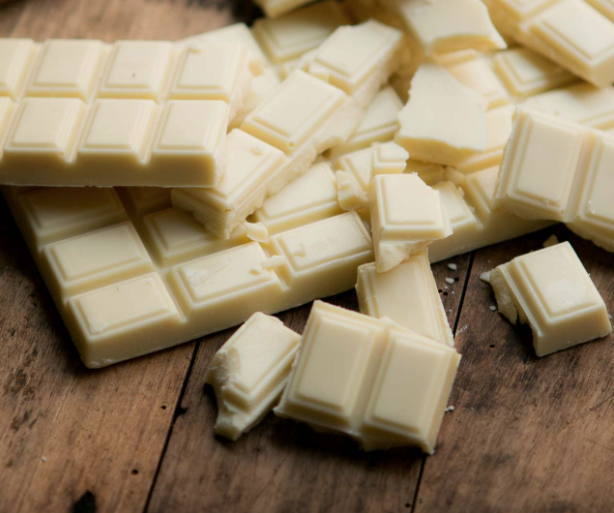By: Heidi Wagenbach
Some people love it, others hate it. White chocolate creates divisive and opinionated points of view for many, the argument that it’s not even chocolate being the most popular, despite 45% of its mass comes from cacao beans. I decided to delve into this topic of determining what you should look for when shopping for white chocolate and how to decipher what to use, and what to avoid for baking or noshing.
Taste
Compared to dark chocolate, that neglects cocoa solids, sugar, emulsifiers, and flavors like vanilla, white chocolate swaps out the cocoa for milk solids. White chocolate doesn’t have that sharp bitterness because of this, and its flavor is subtle, smoother, and satiny. Eagranie Yuh, chocolate educator, author of The Chocolate Tasting Kit, and a judge for the International Chocolate Awards stated: “[White chocolate] should taste like good milk, fresh and clean, and it shouldn’t be super sweet.”
Color, Aroma, and Classifications
White chocolate should be a pale yellow, and not a blinding white because that hints at the recipe being bleached. Pastry chef, Stella Parks, said white chocolate has “floral and aromatic cocoa butter qualities.” The FDA determined that white chocolate must contain 20% cocoa butter, at least 14% milk solids, 3.5% milk fat, and a maximum of 55% in sweeteners in order to be deemed as such. Watch out for sugar and fat though, which will result in a sweetness overdose or an oily film covering your tongue. Look for labels such as “white baking chips” or “morsels,” because those contain milk, oil, and sugar and forsake the ingredients that make white chocolate… well, white chocolate.
Uses
White chocolate is made for coating (mm… chocolate-covered strawberries)… and its delicate flavor makes it good for creamy recipes such as ganaches, mousses, ice creams, or glazes. Good white chocolate used for baking requires a high cocoa butter percentage (33% or more). Avoid chocolate chips because they melt poorly; their structure is designed to hold shape under heat and companies substitute hydrogenated oil for cocoa butter and increase the sugar content. If you want chunks, chop up a bar instead. Pair white chocolate with contrasting flavors (i.e. citrus) or opt for the less sweet bars.
Determining What Is Best and What Is Not
Max Falkowitz from Serious Eats created a tasting panel of 21 pastry chefs and chocolate lovers to find the best/worst in the vast array of available white chocolate in the market. They sampled pure white chocolate, with no added fruits or nuts. The brands ranged from mass market to hand-crafted, and while not available in every store, online shopping provided the rest. They came in various sizes and shapes; the judges focused on their raw flavor and rated them based on texture and preferences. Their criteria was to look for a chocolate that melted smoothly, with a clean, creamy, rich (but not too fatty) flavor (that didn’t turn into chalk in your mouth) and a vanilla, floral, cocoa hint that leaned on the moderately sweet side. They found that with each brand, the results were unbalanced, either too sweet, too heavy, or left a nasty aftertaste.
4 Tips And Tricks To Tell If Chocolate Is Good Quality
- Sound – Chocolate should snap upon breaking and shouldn’t crumble. The right quantities of ingredients make it stable and solid, a texture that doesn’t need to be refrigerated.
- Smell – Chocolate should smell like… you guessed it, chocolate or cocoa, not just sweetness or vanilla. It needs to smell like what is used to produce it, not the additives that cover it up. There could be hints of nuttiness, coffee, fruitiness, but the overall odor is indulgent and chocolatey.
- Look – Poor quality chocolate melts alarmingly fast into an oily mouthful or dissolves slowly into a chalky paste. These two different results are because of the usage of vegetable oils or too much sugar/milk powder. The tempering technique also plays a factor. Bad chocolate cannot be melted properly, either seizing/splitting in the microwave or heat from a pan. Good chocolate is silky, delicious, and is a treat you shouldn’t even have to chew really.
- Taste – Good quality chocolate satisfies in small amounts. It depends on your taste, of course, because chocolate varies for every palette, whether you enjoy dark or light. Either option should not be binged and a bite or two will be enough to curb your sweet tooth.
Enjoy chocolate in a healthier way, both your body and wallet will thank you later. You’ll be able to get nutrients while saving money on not diminishing your earnings on poorly made chocolate.
Sources
5 Ways to Tell if Chocolate is Good Quality
The Real Deal With White Chocolate, Desserts’ Delicious Underdog
What to Look for When Buying White Chocolate

